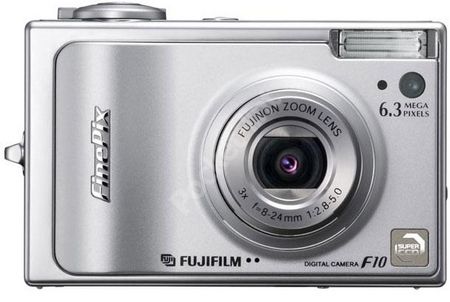The F10 boasts the companies new, 1/1.7-inch Super CCD HR sensor that uses a full 6.3-million gross pixels rather than the interpolated, dual pixel elements of yore. Fujifilm's Super CCD technology has been with us for some time now and it just keeps getting better and to prove the point the F10 has its best incarnation yet in a camera of this class.
Our quick take
Fuji's Super CCD HR sensor really struts its stuff in the F10, a camera that is built well, is simple to use and produces some stunning images. I have to say it is quite simply excellent.

Fuji FinePix F10 Digital Camera - 4.5 / 5
| FOR | AGAINST |
|---|---|
|
|
Look over the camera which, it has to be said, seems a tad conservative design wise given many of today's stylish-looking models, it is still quite svelte and very well made with an all-mental body that oozes class.
A large four-position switch on the top plate switches the camera between its scene, auto and manual shooting modes and the excellent 640x480-pixel, 30fps with sound movie capture setting; a central shutter release button completes the top plate controls apart from…
A power switch, which sits adjacent to the four-way controller and must be held down for around a second to switch the camera on preventing accidental activation. On the camera's back, a large 2.5in and 115,000-pixel screen hogs the real estate, pushing all the other camera controls over to the right. These are quite small and the four-way controller has a central Menu/OK button.
A playback button (which, like the power button, can be held for around a second when the camera's off to activate playback without opening the lens) and an ‘F' button are above the four way control. The ‘F' button accesses the camera's separate menus for image size and quality settings and is simple to use.
The camera lacks the usual gamut of scene modes plumping instead for four basic scene modes (portrait, landscape, sports and night scene modes) and a natural light mode. There's an auto shooting mode for, well, point and shooting plus a manual position that provides an extended menu system offering slightly more advanced settings for exposure compensation to +/-2EV in 1/3rd f-stop steps and white balance control. There's no control for shutter or apertures though.
All of these must be mastered through a slow and initially fiddly menu system that takes some getting used to. However, the menu glitches are more than outweighed by the camera's performance, which is pretty much class-leading in terms of responsiveness, lack of shutter lag and the rechargeable battery life - in our tests it lasted up to 500 shots on a single charge in normal shooting.
If you switch to a neat High Speed shooting mode, the focusing speed is dramatically increased and the effective focus distance is altered slightly from 1m to infinity (you can get from 7.5cm in ‘normal' macro shooting for example) and it reduces the battery life significantly too but you still get around 300-shots on a single charge, still very respectable. My test bore this out as a single charge lasted almost a week worth of snapping including reviewing and plenty of flash work too.
The built in flash is quite good, though it overpowered some of my closer portraits, and the recycle time is very slow indeed when compared to the speediness of the rest of the camera.
Image quality can be summed up quite succinctly as excellent. The level of detail outstrips many of the 7-megapixel digicams on the market. This fact is largely due to the very nice, sharp, F2.8 to F5, 3x optical zoom lens that gives a focal range from 36mm to 108mm (35mm equiv.), it has to be said however, that it's still a fairly standard lens range for today's digital compacts.
Colour and exposure is consistent and spot on, focusing is similarly reliable and noise, or lack thereof, is superbly controlled. Even at the camera's top ISO 1600 sensitivity setting, you get a noise level normally arrived at ISO 400 on other digital cameras. Only very slight pixel fringing on contrast boundaries are image demerits of note.
To recap
The Fuji FinePix F10 is a little cracker that provides a simple to use and it’s a good price too.
